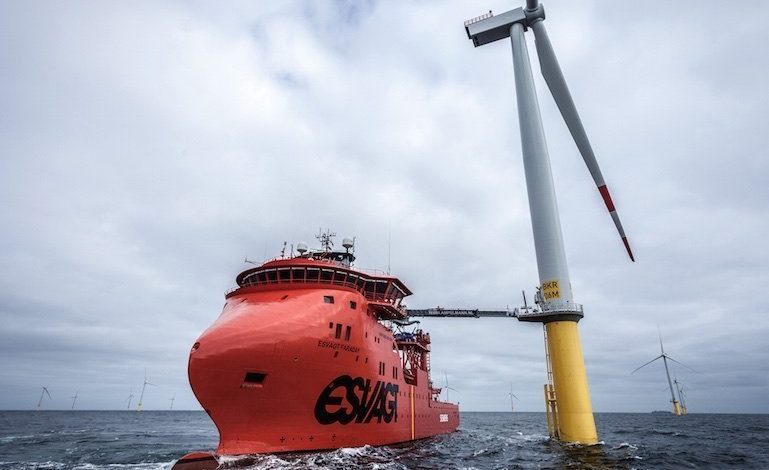Europe piles in with massive offshore wind orders as prices drop

Pareto Securities is predicting offshore wind costs will become lower than onshore wind and solar by 2030, something not lost on European governments who have been investing ever increasing sums, propelling enormous changes across the continent’s coastlines.
“In eight years, offshore wind has gone from a heavily subsidised niche to a mainstream asset class competitive with all other energy sources in Europe,” Pareto analyst Baard Rosef told a webinar yesterday.
Latest data from WindEurope, a lobby group, show European countries ordered a record 15 GW of wind turbines in 2020, up 74% year-on-year. Onshore wind turbine sales increased by 13% in 2020 to 8.2 GW, while offshore orders grew six-fold compared to the previous years to 6.4 GW with the UK leading the way.

Wind power remains an intermittent source of generation input. It has generated very low levels (low single digits) during the current UK winter months. Ditto solar. It has been heavily subsidized and receives hidden support in the form to connection to national grid links. The economics of windpower do not stand up to close economic scrutiny. It is being developed on the altar of green credentials. The supporters of this technology set never mention the need for equivalent back up power and more when wind is not operational (it cannot operate in very high winds).
Batteries, batterries and more batteries = super power. Wind will supply enough, with solar as backup and loads of Batteries to store the excess power. And its economically the cheapest way to make power.
So, Phil, what are the economics involved in paying for pollution from coal and gas and oil fired plants? That’s born by tax payers who fund the health system. Why doesn’t the polluter (the power generator) pay? Who also pays for land lost to sea level rise and ever more destructive storms. If the polluter paid, that would pretty soon end fossil fuel power generation as well as internal combustion powered car production. We have subsidised the fossil fuel industry for 200 yrs, by allowing it to use the atmosphere as a dustbin. It’s got to stop now, before we either die from the filth we are breathing or from the wrath of Mother Nature. Look beyond the end of your nose and you’ll see the truth.
False. Advocates of renewables are well aware of intermittence of sources and research on storage is part of the push. Gas back up is not renewable, no matter how the fossil advocates try to twist it.
The economics of both wind and solar obviously *do* stand up to economic scrutiny, otherwise governments around the world wouldn’t be continuing to move in this direction. These technologies don’t exist in insolation though, and are supported by the use of large-scale battery systems that store the energy at night or when the wind isn’t blowing.
These technologies are being developed for one reason: they have become much cheaper than alternative energy sources, and will continue to get even cheaper as the technologies mature.
You’re stating nothing new; everyone knows the sun doesn’t always shine and the wind doesn’t always blow. Energy companies like Tesla are miles ahead of you, and have already addressed the need for energy storage solutions. Google “Hornsdale Power Reserve” to discover how your misplaced concerns were addressed 4 years ago by, for example, the South Australian government. You really need to keep up with advancements before further embarrassing yourself on a public website.
You could almost say the same thing for every form of electrical generation.
– fossil fuels in general fail to fully price in the cost of co2 which is closer to £200/tonne than £20 which it’s fixed at
– gas a deeply intermittent if the pipeline runs across Europe and has Russia on the other end of it
– biomass (drax) is heavily subserdised
– nuclear can’t pay to be built or decommissioned
In the next stage of CFD contracting then these should be let as baseload and dispatchable power. This then uses the market to determine the assets which are required to do this so for example Coire Glas and hornsea bank. This creates a way for storage assets to be paid for and develop new storage options.
You may also find at a fully costed scenario that nuclear, tidal, pumped storage and geothermal become cost effective. But joined up thinking is rarely something which large risk adverse organisations do well.
Phil’s views risk being overtaken with the passage of time. Today’s offshore wind projects are being contracted at zero CfD, the modern offshore wind turbines are being touted as “variable baseload” by IEA because of capacity factors in excess of 50% and the backup power is being provided by an increasing network of interconnectors.